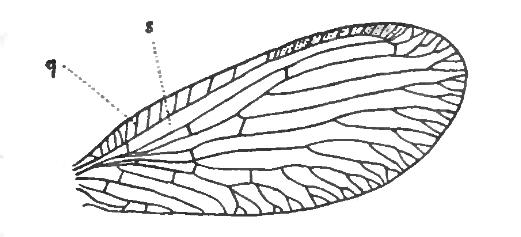|
Coniopterygoidea
Coniopterygoidea is a superfamily in the lacewing order Neuroptera which is considered the basal most linage in the order and sister to all other neuropteran clades. The superfamily includes the single living family Coniopterygidae (dustywings). In past classifications, Coniopterygoidea was expanded to include Sisyridae (spongillaflies) and placed in the paraphyletic suborder Hemerobiiformia The Hemerobiiformia are a suborder of insects in the order Neuroptera. The phylogeny of the Neuroptera was explored in 2014 using mitochondrial DNA sequences. The results indicate that the traditional Hemerobiiformia are paraphyletic, meaning th .... References {{Neuroptera-stub ... [...More Info...] [...Related Items...] OR: [Wikipedia] [Google] [Baidu] |
Coniopterygidae
The dustywings, Coniopterygidae, are a family of Pterygota (winged insects) of the net-winged insect order ( Neuroptera). About 460 living species are known.Engel & Grimaldi (2007) These tiny insects can usually be determined to genus with a hand lens according to their wing venation, but to distinguish species, examination of the genitals by microscope is usually necessary. Description and ecology In general habitus, the adults are quite unlike other net-winged insects. Because of their small size - wingspan is between 1.8 and 5 millimetres - and their translucent brownish wings usually covered with the namesake whitish dust of waxy scales, they may at first be mistaken for whiteflies (Aleyrodidae). But whiteflies are true bugs (Sternorrhyncha), which are only distantly related to net-winged insects. An easily-perceived distinguishing feature to separate whiteflies from dustywings is, that like many other Neuroptera, dustywings carry their wings nearly side-by-side when at res ... [...More Info...] [...Related Items...] OR: [Wikipedia] [Google] [Baidu] |
Sisyridae
Sisyridae, commonly known as spongeflies or spongillaflies, are a family of winged insects in the order Neuroptera. There are approximately 60 living species described, and several extinct species identified from the fossil record. Description In general appearance, the adults resemble some brown lacewings (Hemerobiidae). The forewings of spongillaflies have a span of 4–10 millimetres. The greyish or brownish wings have few cross veins except in the costal field, and most of these are not forked. The subcostal (Sc) and radial (R1) veins are fused near the wingtip. The larvae of spongillaflies look rather bizarre. Similar to those of some osmylids ( Osmylidae) at first glance, they have spindly legs on a bulky thorax, long antennae, and flexible, threadlike mouthparts. However, the second and third instars carry seven pairs of jointed, movable tracheal gills beneath their plump abdomen. These gills are possessed by no other extant insect family, and readily distinguish the ... [...More Info...] [...Related Items...] OR: [Wikipedia] [Google] [Baidu] |
Neuroptera
The insect order Neuroptera, or net-winged insects, includes the lacewings, mantidflies, antlions, and their relatives. The order consists of some 6,000 species. Neuroptera can be grouped together with the Megaloptera and Raphidioptera in the unranked taxon Neuropterida (once known as Planipennia) including: alderflies, fishflies, dobsonflies, and snakeflies. Adult Neuropterans have four membranous wings, all about the same size, with many veins. They have chewing mouthparts, and undergo complete metamorphosis. Neuropterans first appeared during the Permian period, and continued to diversify through the Mesozoic era. During this time, several unusually large forms evolved, especially in the extinct family Kalligrammatidae, often called "the butterflies of the Jurassic" for their large, patterned wings. Anatomy and biology Neuropterans are soft-bodied insects with relatively few specialized features. They have large lateral compound eyes, and may or may not also have ocel ... [...More Info...] [...Related Items...] OR: [Wikipedia] [Google] [Baidu] |
Hemerobiiformia
The Hemerobiiformia are a suborder of insects in the order Neuroptera. The phylogeny of the Neuroptera was explored in 2014 using mitochondrial DNA sequences. The results indicate that the traditional Hemerobiiformia are paraphyletic, meaning that not all the members of the clade are considered to belong to it, in particular since it would include all the Myrmeleontiformia, with which the Hemerobiiformia were traditionally contrasted. The Osmyloidea, usually included in Hemerobiiformia, actually seem to represent a more ancient lineage basal Basal or basilar is a term meaning ''base'', ''bottom'', or ''minimum''. Science * Basal (anatomy), an anatomical term of location for features associated with the base of an organism or structure * Basal (medicine), a minimal level that is nec ... to Hemerobiiformia as well as Myrmeleontiformia. The broken-up group is shown in the cladogram: References External links * * Insect suborders {{Neuroptera-stub ... [...More Info...] [...Related Items...] OR: [Wikipedia] [Google] [Baidu] |
Conwentzia Psociformis
''Conwentzia'' is a genus of net-winged insects belonging to the family Coniopterygidae or ''dustywings''. ''Conwentzia'' species are present in most of Europe. These tiny insects, also known as waxwing lacewings or dustywing lacewings. They have only vestigial hindwings. Body and forewings are covered with whitish dust of waxy scales which the insect produces itself. Forewings are carried nearly side-by-side when at rest, like many other Neuroptera. To distinguish various species, an accurate study of the genitals by microscope is usually necessary. Species * ''Conwentzia africana'' * ''Conwentzia barretti'' * ''Conwentzia californica'' * ''Conwentzia capensis'' * ''Conwentzia fraternalis'' * ''Conwentzia inverta'' * ''Conwentzia nietoi'' * ''Conwentzia obscura'' * ''Conwentzia orthotibia'' * ''Conwentzia pineticola'' * '' Conwentzia psociformis'' * ''Conwentzia sabae'' * ''Conwentzia sinica'' * ''Conwentzia yunguiana ''Conwentzia'' is a genus of net-winged insects belongin ... [...More Info...] [...Related Items...] OR: [Wikipedia] [Google] [Baidu] |

